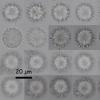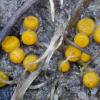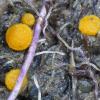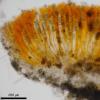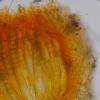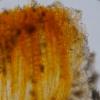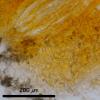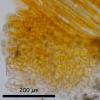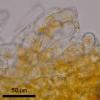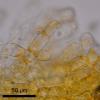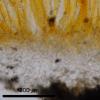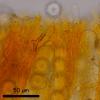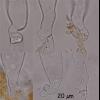
07-08-2010 15:51
Marja PennanenSo I've been forced to seek damp places. The botto

06-08-2010 22:22
 Jean Pierre Dechaume
Jean Pierre Dechaume
Peziza de 2-3 cm, sur terre nue avec jeunes mousse

06-08-2010 00:51
 Martin Bemmann
Martin Bemmann
Hi all, does someone have a copy of Redhead's p

03-08-2010 01:26
Marja PennanenHello folks, I found something on mosses (so I th

02-08-2010 23:49
 Martin Bemmann
Martin Bemmann
Hi, did someone of you try to make a slide of B

23-07-2010 21:59
 Christian Lechat
Christian Lechat
Dear friends, you can consult the document about

23-07-2010 14:33
Quijada LuisDears researchers, I will try to get a series of p
Ramsbottomia crec'hqueraultii 280815 287
Miguel 횁ngel Ribes,
06-08-2016 20:49
 Hi friends
Hi friendsI have this Ramsbottomia with rounded spores and mixed characters between R. crec'hqueraultii and R. macracantha.
Spores (1000x, H2O, live, without ornamentation):혻(19,2) 20,3 - 23,4 (23,6) 횞 (19) 20,2 - 22,7 (22,9) 쨉m;혻Q = 1 ; N = 37;혻Me = 21,8 횞 21,4 쨉m; Qe = 1.
Ornamentation length: (2,2) 2,6 - 3,9 (4,2) 쨉m;혻N = 45;혻Me = 3,3 쨉m.
I think it is nearest R. crec'hqueraultii than macracantha because Me spores are 21,8 x 21,4 (only a little bigger than 20 쨉m) and ornamentation is Me = 3,3 쨉m, but all papers I have read have spore measures for crec'hqueraltii < 20 쨉m and spiner never > 3,5 쨉m. And in this collection some spines have a very broad base.
Perhaps my collection is a "joung" R. macracantha?
Thank you in advance.
Nicolas VAN VOOREN,
07-08-2016 09:53

Re : Ramsbottomia crec'hqueraultii 280815 287
Hi Miguel.
You lost your Cotton Blue 혻;-)
It would be interesting to know more about the other characters, especially the "hairs", and the habitat.
You lost your Cotton Blue 혻;-)
It would be interesting to know more about the other characters, especially the "hairs", and the habitat.
Miguel 횁ngel Ribes,
07-08-2016 17:50

Re : Ramsbottomia crec'hqueraultii 280815 287
Jejeje, don't worry Nico, next time, despite this impressive ornamentation, I will use CB, CRB or another blue.
This Ramsbottomia was neighbor of Boudiera tracheia, at alpine place, in a very, very humid slope of a small stream, between mosses, with Juncus, Aconitum and another small herbs.
An this are the pictures.
This Ramsbottomia was neighbor of Boudiera tracheia, at alpine place, in a very, very humid slope of a small stream, between mosses, with Juncus, Aconitum and another small herbs.
An this are the pictures.
Nicolas VAN VOOREN,
09-08-2016 19:07

Re : Ramsbottomia crec'hqueraultii 280815 287
Hi.
In alpine zone, the most common species is R. asperior, but the spores of this collection seem to be too large (and not enough subglobose) to fit the latter.
R. lamprosporoidea is another hypothesis, but the "hairs" should be more coloured and longer (I think you remember our discussion about this taxon and some Pyrenean collections).
In all cases keep this collection, a DNA sequence could be useful to clarify the taxonomy of each taxon...
In alpine zone, the most common species is R. asperior, but the spores of this collection seem to be too large (and not enough subglobose) to fit the latter.
R. lamprosporoidea is another hypothesis, but the "hairs" should be more coloured and longer (I think you remember our discussion about this taxon and some Pyrenean collections).
In all cases keep this collection, a DNA sequence could be useful to clarify the taxonomy of each taxon...
Miguel 횁ngel Ribes,
09-08-2016 19:40

Re : Ramsbottomia crec'hqueraultii 280815 287
Hi Nico
We have a collection of R. lamprosporoidea published in "Contribuci처n al conocimiento de la micobiotal de Parque Natual de la Sierra Norte de Guadalajara. Cat찼logo y especies m찼s interesantes I. Bol. Soc. Micol. Madrid 38: 163-181. 2014" (link here: https://www.dropbox.com/s/kilf85z3nt3683z/Contribucion%20conocimiento%20micobiota%20del%20PN%20Sierra%20Norte%20de%20Guadalajara%20-%20Campos%202014.pdf?dl=0):
* with subglobose spores, not rounded, (16,1-)16,9-18,9(-19,3)혻x (13,8-)14,8-17(-17,4) m쨉혻Q = (1-)1,05-1,18(-1,2);혻N = 41; Me = 17,9 x 16 쨉m혻; Qe = 1,1.
* with darker hairs of혻(72,3-)103,5-134,9(-162,3) x혻(11,7-)13,3-22(-24,3) 쨉m; N = 34; Me = 118 x 17,5혻쨉m
The length hairs is similar in both collection, but not the spore shape.
We could try to sequenced it.
Thank you.
We have a collection of R. lamprosporoidea published in "Contribuci처n al conocimiento de la micobiotal de Parque Natual de la Sierra Norte de Guadalajara. Cat찼logo y especies m찼s interesantes I. Bol. Soc. Micol. Madrid 38: 163-181. 2014" (link here: https://www.dropbox.com/s/kilf85z3nt3683z/Contribucion%20conocimiento%20micobiota%20del%20PN%20Sierra%20Norte%20de%20Guadalajara%20-%20Campos%202014.pdf?dl=0):
* with subglobose spores, not rounded, (16,1-)16,9-18,9(-19,3)혻x (13,8-)14,8-17(-17,4) m쨉혻Q = (1-)1,05-1,18(-1,2);혻N = 41; Me = 17,9 x 16 쨉m혻; Qe = 1,1.
* with darker hairs of혻(72,3-)103,5-134,9(-162,3) x혻(11,7-)13,3-22(-24,3) 쨉m; N = 34; Me = 118 x 17,5혻쨉m
The length hairs is similar in both collection, but not the spore shape.
We could try to sequenced it.
Thank you.
